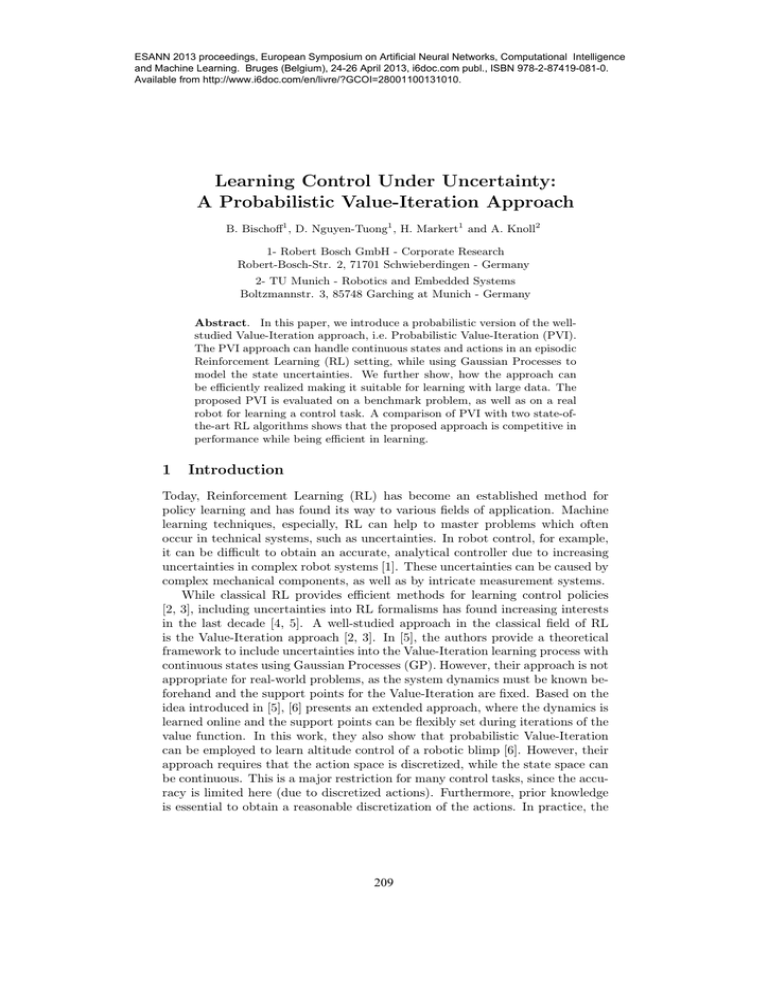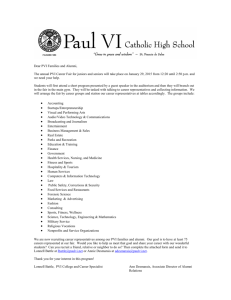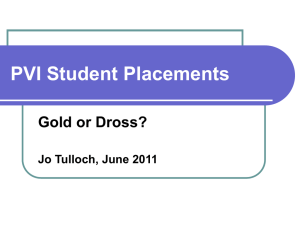A Probabilistic Value-Iteration Approach
advertisement

ESANN 2013 proceedings, European Symposium on Artificial Neural Networks, Computational Intelligence
and Machine Learning. Bruges (Belgium), 24-26 April 2013, i6doc.com publ., ISBN 978-2-87419-081-0.
Available from http://www.i6doc.com/en/livre/?GCOI=28001100131010.
Learning Control Under Uncertainty:
A Probabilistic Value-Iteration Approach
B. Bischoff1 , D. Nguyen-Tuong1 , H. Markert1 and A. Knoll2
1- Robert Bosch GmbH - Corporate Research
Robert-Bosch-Str. 2, 71701 Schwieberdingen - Germany
2- TU Munich - Robotics and Embedded Systems
Boltzmannstr. 3, 85748 Garching at Munich - Germany
Abstract. In this paper, we introduce a probabilistic version of the wellstudied Value-Iteration approach, i.e. Probabilistic Value-Iteration (PVI).
The PVI approach can handle continuous states and actions in an episodic
Reinforcement Learning (RL) setting, while using Gaussian Processes to
model the state uncertainties. We further show, how the approach can
be efficiently realized making it suitable for learning with large data. The
proposed PVI is evaluated on a benchmark problem, as well as on a real
robot for learning a control task. A comparison of PVI with two state-ofthe-art RL algorithms shows that the proposed approach is competitive in
performance while being efficient in learning.
1
Introduction
Today, Reinforcement Learning (RL) has become an established method for
policy learning and has found its way to various fields of application. Machine
learning techniques, especially, RL can help to master problems which often
occur in technical systems, such as uncertainties. In robot control, for example,
it can be difficult to obtain an accurate, analytical controller due to increasing
uncertainties in complex robot systems [1]. These uncertainties can be caused by
complex mechanical components, as well as by intricate measurement systems.
While classical RL provides efficient methods for learning control policies
[2, 3], including uncertainties into RL formalisms has found increasing interests
in the last decade [4, 5]. A well-studied approach in the classical field of RL
is the Value-Iteration approach [2, 3]. In [5], the authors provide a theoretical
framework to include uncertainties into the Value-Iteration learning process with
continuous states using Gaussian Processes (GP). However, their approach is not
appropriate for real-world problems, as the system dynamics must be known beforehand and the support points for the Value-Iteration are fixed. Based on the
idea introduced in [5], [6] presents an extended approach, where the dynamics is
learned online and the support points can be flexibly set during iterations of the
value function. In this work, they also show that probabilistic Value-Iteration
can be employed to learn altitude control of a robotic blimp [6]. However, their
approach requires that the action space is discretized, while the state space can
be continuous. This is a major restriction for many control tasks, since the accuracy is limited here (due to discretized actions). Furthermore, prior knowledge
is essential to obtain a reasonable discretization of the actions. In practice, the
209
ESANN 2013 proceedings, European Symposium on Artificial Neural Networks, Computational Intelligence
and Machine Learning. Bruges (Belgium), 24-26 April 2013, i6doc.com publ., ISBN 978-2-87419-081-0.
Available from http://www.i6doc.com/en/livre/?GCOI=28001100131010.
size of the discrete action sets grows exponentially with the number of action
dimensions and, hence, making it inefficient for complex learning problems.
In this paper, we take a step forward and formulate a probabilistic ValueIteration approach (PVI), where the action and state spaces can be both continuous. Thus, the optimal action can now be found efficiently using gradient-based
search, where analytical gradients for the PVI are provided. Furthermore, the
dynamics model can be learned online and the support points of the value function are selected using a kernel-based criterion. We evaluate our PVI algorithm
on the simulated mountain-car benchmark problem first. In more advanced experiments, we test the algorithm on a simulated robot, as well as on the mobile
robot Festo Robotino, see Figure 4. Here, the control task for the mobile robot is
moving to a desired goal position from a given starting point. We also compare
our PVI approach with two other RL algorithms, e.g. Pilco [4] and Neural fitted
Q-Iteration (NFQ) [7]. The remainder of the paper will be organized as follows:
first, we provide a brief review on classical RL. In Section 3, we describe our
PVI algorithm in details. Section 4 provides evaluations and robot experiments
using the proposed method. A conclusion will be given in Section 5.
2
Reinforcement Learning and Value-Iteration
In this section, we provide a short overview on the basic concepts of RL with
focus on Value-Iteration [2, 3]. RL describes the concept of goal directed learning
of an agent by interacting with a system. The state of the agent is given as s ∈ S,
the agent can apply actions a ∈ A to move to new states s ∈ S. The transition
probability is given by p(s, a, s ) representing the dynamics. A policy π : S → A
determines in every state the action to be used. The user-defined reward function
R : S × A × S → R rates transitions and, thus, encodes the desired goal. The
latent long term reward for a given policy π is the sum of expected rewards, and
can be written as given in equation (1). Here, Vπ denotes the value function of π,
γ is a discount factor, with 0 < γ < 1. The goal of RL is to obtain a policy π ∗ that
maximizes the long term reward, i.e. Vπ∗ (s) = maxπ∈Π {Vπ (s)} for all states
s ∈ S. The optimal policy π ∗ can be obtained from Vπ∗ by solving equation
(2). A well-studied approach to estimate Vπ∗ is Value-Iteration [2]. Here, the
functions V k are calculated iteratively using equation (3), which is guaranteed
to converge to Vπ∗ under some mild assumptions [8].
Vπ (s) =
p(s, π(s), s ) [R(s, π(s), s ) + γVπ (s )]
(1)
s ∈S
∗
π (s) = arg max
a∈A
∀s ∈ S : V k+1 (s) = max
a∈A
p(s, a, s ) [R(s, a, s ) + γVπ∗ (s )]
(2)
s ∈S
p(s, a, s ) R(s, a, s ) + γV k (s )
(3)
s ∈S
However, the suitability of Value-Iteration for practical control tasks, e.g. in
robotics, is limited. Classical Value-Iteration considers in most cases only dis-
210
ESANN 2013 proceedings, European Symposium on Artificial Neural Networks, Computational Intelligence
and Machine Learning. Bruges (Belgium), 24-26 April 2013, i6doc.com publ., ISBN 978-2-87419-081-0.
Available from http://www.i6doc.com/en/livre/?GCOI=28001100131010.
crete states and actions. Rasmussen and Kuss [5] proposed an approach to generalize Value-Iteration for continuous state spaces. Furthermore, they extend
Value-Iteration learning for uncertain cases, while using GP to model the value
function and dynamics. However, their value function needs to be estimated for
a fixed set of support points. Following the work by [5], Rottmann proposed a
further extension, where support points and dynamics can be learned [6]. However, the action space is still discretized, which implies some disadvantages, such
as prior knowledge for action discretization, limitation in control accuracy, and
exponential grow of actions with the number of dimensions. In this work, we
present a further development for Value-Iteration allowing continuous actions.
3
Probabilistic Value-Iteration (PVI)
Value-Iteration can be extended to continuous states and actions by replacing the
sums in equations (1)–(3) with integrals, see e.g. (4). To model the uncertainty
in the dynamics and states, we employ GP, as previously proposed in [5]. Given
the dynamics model, the distribution of the next state p(s ) given action a is
estimated as Gaussian distribution with mean μs and covariance Σs . For a given
as given in
set of support points s ∈ Ssp , the value function V k (s) can be learned,
equation (5). A GP is employed to generalize from the values V k (s) | s ∈ Ssp
of the support points to the entire
state space.
k+1
∀s ∈ Ssp : V
(s) = max p(s, a, s ) R(s, a, s ) + V k (s ) ds
(4)
a∈A
(5)
∀s ∈ Ssp : V k+1 (s) = max R(s, a, s | μs , Σs ) + γV k (s | μs , Σs )
a∈A
π(s) = arg max (R(s, a, s | μs , Σs ) + γV (s | μs , Σs )) .
(6)
a∈A
To determine Ssp , we generate points by policy application and thereof select
the set of support points incrementally and online while employing a kernelbased criterion [1]. Here, the basic idea is to select points being “far away” from
a linear span in the feature space defined by the support
n set. Thus, given the
support set Ssp = {si }ni=1 , the measure δ(snew ) = i=1 ai φ(si ) − φ(snew ) is
computed, where φ is the feature vector and ai represent the linear coefficients.
The new point snew is included into the support set, when δ is larger than a given
threshold value. The measure δ can be written in terms of kernels incorporating
the feature representation φ. More details can be found in [1].
To sample the dynamics in the relevant state space region, we employ episodic
RL. First, we sample dynamics data using the learned policy. Subsequently, we
learn the dynamics model based on sampled data and improve the policy based
on the learned dynamics model. These steps are iterated till convergence. The
basic concept of PVI is showed in Algorithm 1. As the action space is continuous,
we solve equation (6) using gradient-based search for finding an optimal policy
π. In the following, we provide the required analytical gradients. Due to space
limitations, we only give the gradients of the value-function ∂V (s )/∂a, i.e.
∂(λq T β)
∂λ T
∂q T
∂V (s |μs , Σs )
=
=
q β + λ (i) β
(i)
(i)
(i)
∂a
∂a
∂a
∂a
211
ESANN 2013 proceedings, European Symposium on Artificial Neural Networks, Computational Intelligence
and Machine Learning. Bruges (Belgium), 24-26 April 2013, i6doc.com publ., ISBN 978-2-87419-081-0.
Available from http://www.i6doc.com/en/livre/?GCOI=28001100131010.
Algorithm 1 Probabilistic Value-Iteration (PVI)
1:
2:
3:
4:
5:
6:
7:
8:
9:
10:
Apply random actions on system to obtain initial dynamics data D
for e = 1 to Episodes do
Train GP with D to estimate system dynamics p
repeat
Generate set of support points Ssp
∀s ∈ Ssp : V k+1 (s) = maxa∈A R(s, a, s | μs , Σs ) + γV k (s | μs , Σs )
Train GP V k+1 with targets V k+1 (s)
until convergence
Apply current policy π on system, increment D with new dynamics data
end for
where we employ the parametrization V (s |μs , Σs ) = λq T β, as proposed in [9].
Here, q = exp(− 12 (μs − Ssp )T (ΛV + Σs )−1 (μs − Ssp )), β = K(Ssp , Ssp )V (Ssp )
− 12
and λ = |Λ−1
. The other gradient ∂R(s, a, s )/∂a, see equation (6),
V Σs + I|
can be computed accordingly and will be provided in a longer version of the
is given for the squared exponential kernel, i.e.
paper. The derivative
1∂V (s )/∂a
2
kse (x, x ) = σf exp − 2 (x − x )T Λ−1 (x − x ) , resulting in
∂q
λ
1 T ∂Σs
∂λ
−1
−1 −1 ∂Σs
T ∂μs
;
= − T r (ΛV Σs + I) ΛV
= q −A
+ A
A
2
2
∂a(i)
∂a(i) ∂a(i)
∂a(i)
∂a(i)
with A = (ΛV + Σs )−1 (μs − Ssp ) and ∂Σs /∂a(i) , ∂μs /∂a(i) are given as
∂k([s, a], Xdyn )
∂k([s, a], Xdyn )
1
∂μs
=
Kdyn ydyn ;
= exp − CB (−Cαi )
2
∂a(i)
∂a(i)
∂a(i)
∂Σs
∂k([s, a], Xdyn )
∂k(Xdyn , [s, a])
=
Kdyn k(Xdyn , [s, a]) + k([s, a], Xdyn )Kdyn
∂a(i)
∂a(i)
∂a(i)
with B = ([s, a]−Xdyn ), C = B T Λ−1
dyn and αi equals 1 at the entry corresponding
to action-dimension i and 0 else. Further, Λdyn and ΛV are hyper-parameters of
the dynamics respectively value-function GP, Xdyn , ydyn are sampled dynamics
data.
4
Evaluation
In this section, we evaluate PVI in simulation, as well as on a mobile robot, e.g.
the Robotino in Figure 4. We compare the results of PVI to Pilco [4] and NFQ
[7]. For all evaluations,
we use a saturated immediate reward (see [4]) defined
by R(s) = exp − 2c12 |s − sgoal | with Euclidean norm | · |.
First, we compare the algorithms on the well-known mountain-car task. The
state space consists of positions and velocities of the car. The starting position
is in the valley, the goal is to drive uphill and stay at the slope. As can be
seen in Figure 1, PVI, Pilco and NFQ all converge to a similar solution (which is
nearly optimal). However, PVI and Pilco are more efficient and find the solution
already after 2 respectively 4 episodes.
212
ESANN 2013 proceedings, European Symposium on Artificial Neural Networks, Computational Intelligence
and Machine Learning. Bruges (Belgium), 24-26 April 2013, i6doc.com publ., ISBN 978-2-87419-081-0.
Available from http://www.i6doc.com/en/livre/?GCOI=28001100131010.
Figure 1: Comparison of PVI, Pilco
and NFQ on the mountain-car task.
Figure 2: Comparison of PVI, Pilco
and NFQ on a 1m robot translation
task simulated in Gazebo.
Figure 3: Learning results for translation tasks on the Robotino, exemplary 1m forward translation.
Table 1: Robotino translation task,
accuracy at the end position for all
four directions.
Before we employ the learning algorithms on the
Robotino, we first compare the algorithms in a robot
simulation. Here, the robot is modelled to be similar
to the real Robotino. The robot state s ∈ R3 corresponds to x, y-position and yaw θ of the mobile robot.
The task is to control the rotational speed of the wheels
to achieve 1m forward translation. For all learning and
evaluation, the cost width was set to c = 0.25. Figure 2
shows, that PVI and Pilco converge successfully to policies after few learning episodes. It turns out that PVI
gains slightly more reward than Pilco, as Pilco’s policy
Figure 4: Robot plat- does not employ the full engine power to accelerate the
form Festo Robotino robot. NFQ is able to drive the robot near the goal,
used for evaluation.
but not accurately enough to gain significant reward.
Finally, we evaluate PVI on the real Robotino for a translation task in 4
directions. The task settings are similar to the simulation, the rotational speed,
i.e. the action a ∈ R3 , of the robot wheels need to be adjusted. For real robot
experiments, we compare our PVI with Pilco. The resulting reward over 5
episodes is shown in Figure 3. After only 3 episodes, PVI and Pilco converge
to successful policies. In these experiments, the policies are learned based on 30
points of dynamics data, i.e. 30 tuples s, a, s . For PVI, the final set of support
213
ESANN 2013 proceedings, European Symposium on Artificial Neural Networks, Computational Intelligence
and Machine Learning. Bruges (Belgium), 24-26 April 2013, i6doc.com publ., ISBN 978-2-87419-081-0.
Available from http://www.i6doc.com/en/livre/?GCOI=28001100131010.
points to estimate the value function included 239 points, choosen by the kernelbased criterion with a threshold of 0.025. While Figure 3 exemplary shows the
reward for 1m forward-translation, the learning results for backward, left and
right translation are similar. The resulting accuracy of the final robot position
is shown in Table 1. As can be seen, all translation tasks can be solved with
high accuracy in the final position.
5
Conclusion
For complex systems, it is difficult to obtain accurate analytical controllers due
to unknown nonlinearities, as well as increasing uncertainty. While RL provides
efficient methods for learning control policy, incorporating uncertainties into RL
formalisms is still a challenging issue. Inspired by the work [5], we presented
an extended version of the well-known Value-Iteration, i.e. PVI, while including
uncertainty into the learning process. The proposed approach is appropriate
for RL learning with continuous states and actions, where the uncertainties are
taking into account by using GP for modelling states and actions. Using PVI,
the dynamics and support points of the value function can be learned from
sampled data. As PVI is formulated for continuous states and actions, efficient
gradient-search can be employed to solve the optimization problem for finding
the optimal action. The approach is evaluated on the mountain-car benchmark
problem, as well as on a real robot control task. A comparison with the state-ofthe-art algorithms, e.g. Pilco and NFQ, shows that our approach is competitive
in performance while efficient in learning.
References
[1] Duy Nguyen-Tuong and Jan Peters. Incremental online sparsification for model learning
in real-time robot control. Neurocomputing, 74(11):1859–1867, 2011.
[2] Richard S. Sutton and Andrew G. Barto. Reinforcement learning: An introduction. IEEE
Transactions on Neural Networks, 9(5):1054–1054, 1998.
[3] M. Wiering and M. van Otterlo. Reinforcement Learning: State-of-the-Art. Adaptation,
Learning, and Optimization. Springer, 2012.
[4] Marc Peter Deisenroth and Carl Edward Rasmussen. Pilco: A model-based and dataefficient approach to policy search. In ICML, pages 465–472, 2011.
[5] Carl Edward Rasmussen and Malte Kuss. Gaussian processes in reinforcement learning.
In NIPS, 2003.
[6] Axel Rottmann and Wolfram Burgard. Adaptive autonomous control using online value
iteration with gaussian processes. In ICRA, pages 2106–2111, 2009.
[7] Martin Riedmiller. Neural fitted q iteration - first experiences with a data efficient neural
reinforcement learning method. In ECML, pages 317–328, 2005.
[8] Eugenio Della Vecchia, Silvia Di Marco, and Alain Jean-Marie. Illustrated review of convergence conditions of the value iteration algorithm and the rolling horizon procedure for
average-cost mdps. Annals OR, 199:193–214, 2012.
[9] A. Girard, J. Q. Candela, R. Murray-Smith, and C. E. Rasmussen. Gaussian Process Priors
with Uncertain Inputs - Application to Multiple-Step Ahead Time Series Forecasting. 2003.
214




